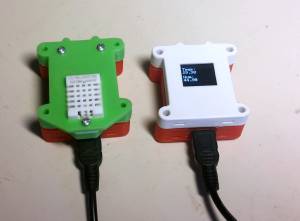This is an old revision of the document!
DHT and OLED example
This example demonstrates how DHT senor can send temperature and humidity readings to the OLED screen with the ITT IoT framework. For this example you will need two controllers. One with the OLED shield and the other with the DHT sensor shield.
Once the code has been uploaded the DHT controller will send temperature and humidity messages via MQTT to the OLED module.
To upload the code you need to create two projects in PlatformIO environment. One for the controller with the OLED shield and the other for the DHT sensor shield.
The following is the code for the controller with the DHT shield. Needed libaries:
lib_deps = ITTIoT@1.0.5, DHT sensor library, Adafruit Unified Sensor
#include <Arduino.h> #include <ittiot.h> #include <DHT.h> #define DHTPIN D3 // Pin where DHT shield is connected. Change this to D4 if your shield has no legs removed. #define DHTTYPE DHT22 // DHT 22 (AM2302) // Create an object for DHT sensor DHT dht(DHTPIN, DHTTYPE); // Message received void iot_received(String topic, String msg) { } // Function started after the connection to the server is established. void iot_connected() { // Send message to serial port to show that connection is established Serial.println("MQTT connected callback"); // Send message to MQTT server to show that connection is established iot.log("IoT DHT example!"); } void setup() { // Initialize serial port and send message Serial.begin(115200); Serial.println("Booting"); // print IoT json config to serial iot.printConfig(); // Initialize IoT library iot.setup(); // Initialize DHT library dht.begin(); } void loop() { // IoT behind the plan work, it should be periodically called iot.handle(); // Read humidity and temperature float h = dht.readHumidity(); float t = dht.readTemperature(); // Create a buffer to store strings to being sent later char buf[10]; // Convert messages to strings and send to the MQTT server String(t).toCharArray(buf,10); iot.publishMsg("temp",buf); delay(1000); String(h).toCharArray(buf,10); iot.publishMsg("hum",buf); delay(1000); }
The following is the code for the controller module with the OLED shield.
lib_deps = ITTIoT@1.0.5, MFRC522, Adafruit GFX Library, Adafruit SSD1306 Wemos Mini OLED
#include <Arduino.h> #include <ittiot.h> #include <SPI.h> #include <Wire.h> #include <Adafruit_GFX.h> #include <Adafruit_SSD1306.h> // Change it according to the real name of the red IoT module where // DHT shield is connected #define DHT_TOPIC "ESP53" // OLED reset pin is GPIO0 #define OLED_RESET 0 // Create an object for OLED screen Adafruit_SSD1306 display(OLED_RESET); // Define variables to store humidity and temperature values float h; float t; // Message received void iot_received(String topic, String msg) { // Check if topic contains temperature data if(topic == (DHT_TOPIC"/temp")) { // Convert string to float t = msg.toFloat(); } // Check if topic contains humidity data if(topic == (DHT_TOPIC"/hum")) { // Convert string to float h = msg.toFloat(); } } // Function started after the connection to the server is established. void iot_connected() { // Send message to serial port to show that connection is established Serial.println("MQTT connected callback"); // Subscribe to get temperature and humidity messages iot.subscribe(DHT_TOPIC"/temp"); iot.subscribe(DHT_TOPIC"/hum"); // Send message to MQTT server to show that connection is established iot.log("IoT OLED example!"); } void setup() { // Initialize serial port and send message Serial.begin(115200); Serial.println("Booting"); // Initialize OLED with the I2C addr 0x3C (for the 64x48) display.begin(SSD1306_SWITCHCAPVCC, 0x3C); // Display "booting..." message display.clearDisplay(); display.setTextSize(1); display.setTextColor(WHITE); display.setCursor(0,0); display.println("Booting..."); display.display(); // print IoT json config to serial iot.printConfig(); // Initialize IoT library iot.setup(); } void loop() { // IoT behind the plan work, it should be periodically called iot.handle(); // Display temperature and humidity readings to oLED screen display.clearDisplay(); display.setTextSize(1); display.setTextColor(WHITE); display.setCursor(0,0); display.println("Temp: "); display.println(t); display.setCursor(0,20); display.println("Hum: "); display.println(h); display.display(); delay(200); }


